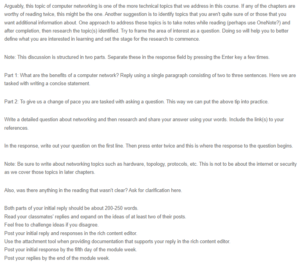Discussion – Computer Networking
The different forms of government play different roles in combating terrorism. The federal government is tasked with sharing information with other international agencies against terrorism. It is also the federal government’s role to protect border points from infiltration by terrorist organizations; this role is played in conjunction with border state governments. On the other hand, the State and local governments act as the first response against any acts of terrorism. These governments are also able to collect more detailed information on the local community against any terrorist organization within the community.
Moreover, the federal government has the responsibility to formulate policies and regulations that are supposed to discourage terrorism while also punishing individuals that are involved in acts of terrorism (Wilalrd et al., 2021). National intelligence on terrorist organizations is also supposed to be carried out by the federal government in cooperation with each state government.
Furthermore, Tribal governments play the role of spreading virtues against terrorism and discouraging their members from joining any terrorist organization. Tribal and local governments have the role of moving information gathered on terror organizations to state and federal governments. All levels of government have the responsibility of cleaning up after any terrorist acts. The governments are also supposed to ensure that damage to property and loss of lives remains at a minimum. The federal government should also allocate and distribute resources towards the prevention and combating of terrorist actions (Magen, 2018).
Despite all the levels of governments playing their role against terror, terrorism has been on the rise, with new terror groups and factions cropping up in various locations. As a result, all levels of government need to conduct more research and implement better strategies for combating terrorism.
References
Magen, A. (2018). Fighting terrorism: The democracy advantage. Journal of Democracy, 29(1), 111-125.
Wilalrd M. Oliver, Nancy E Marion, Joshua B. Hill, (2021), Introduction to Homeland security, Policy, Organization and Administration.
ORDER A PLAGIARISM-FREE PAPER HERE
We’ll write everything from scratch
Question

Discussion – Computer Networking
Arguably, this topic of computer networking is one of the more technical topics that we address in this course. If any of the chapters are worthy of reading twice, this might be the one. Another suggestion is to identify topics that you aren’t quite sure of or those that you want additional information about. One approach to address these topics is to take notes while reading (perhaps use OneNote?) and after completion, then research the topic(s) identified. Try to frame the area of interest as a question. Doing so will help you to better define what you are interested in learning and set the stage for the research to commence.
Note: This discussion is structured in two parts. Separate these in the response field by pressing the Enter key a few times.
Part 1: What are the benefits of a computer network? Reply using a single paragraph consisting of two to three sentences. Here we are tasked with writing a concise statement.
Part 2: To give us a change of pace you are tasked with asking a question. This way we can put the above tip into practice.
Write a detailed question about networking and then research and share your answer using your words. Include the link(s) to your references.
In the response, write out your question on the first line. Then press enter twice and this is where the response to the question begins.
Note: Be sure to write about networking topics such as hardware, topology, protocols, etc. This is not to be about the internet or security as we cover those topics in later chapters.
Also, was there anything in the reading that wasn’t clear? Ask for clarification here.
Both parts of your initial reply should be about 200-250 words.
Read your classmates’ replies and expand on the ideas of at least two of their posts.
Feel free to challenge ideas if you disagree.
Post your initial reply and responses in the rich content editor.
Use the attachment tool when providing documentation that supports your reply in the rich content editor.
Post your initial response by the fifth day of the module week.
Post your replies by the end of the module week.

